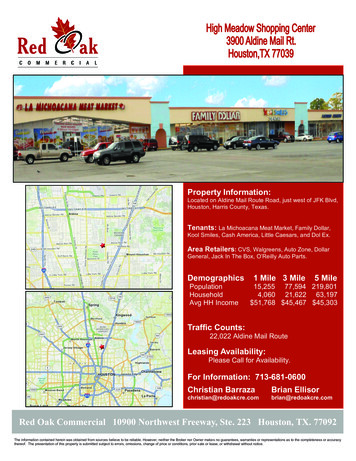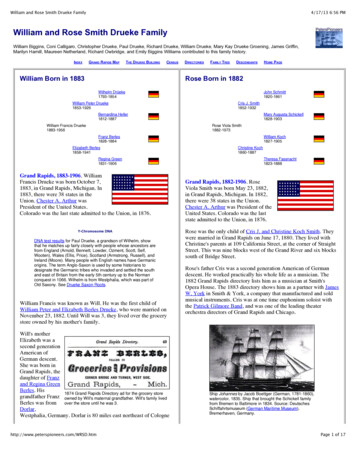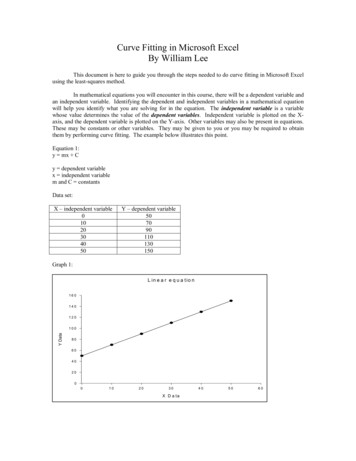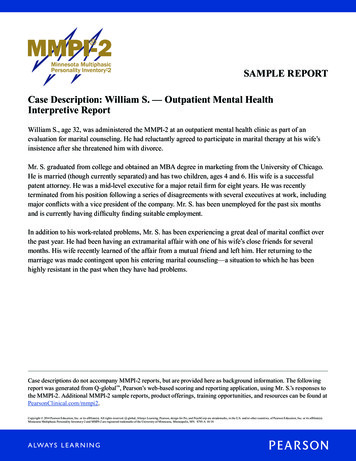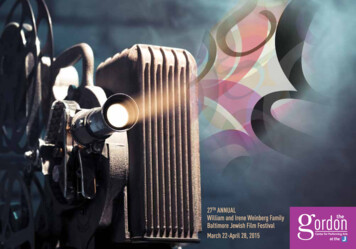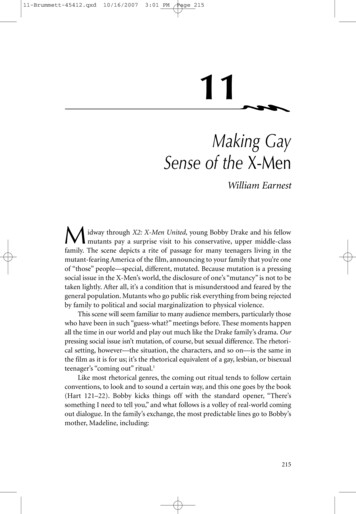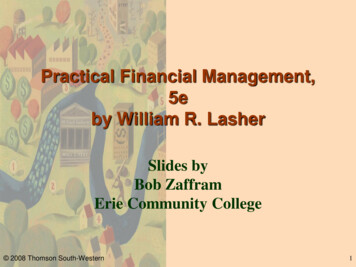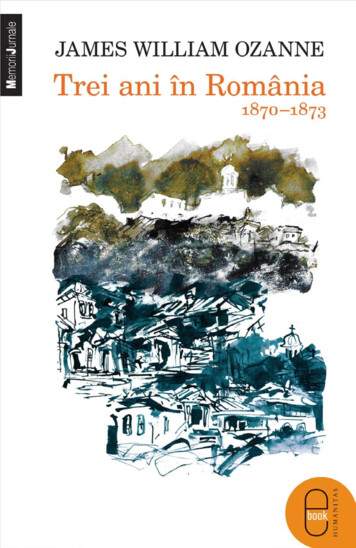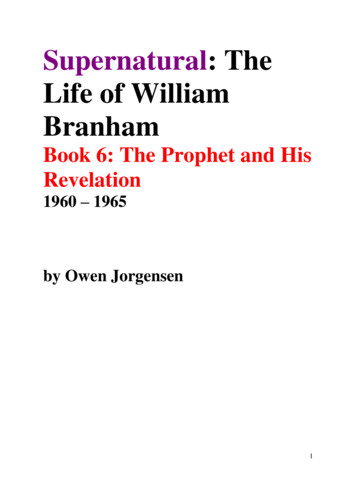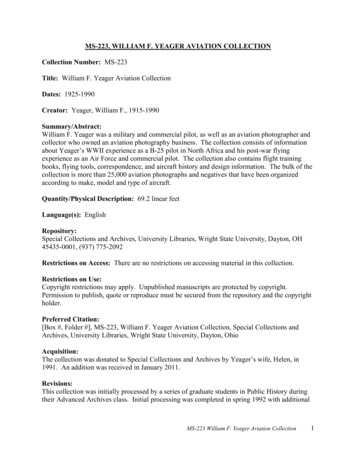
Transcription
MS-223, WILLIAM F. YEAGER AVIATION COLLECTIONCollection Number: MS-223Title: William F. Yeager Aviation CollectionDates: 1925-1990Creator: Yeager, William F., 1915-1990Summary/Abstract:William F. Yeager was a military and commercial pilot, as well as an aviation photographer andcollector who owned an aviation photography business. The collection consists of informationabout Yeager’s WWII experience as a B-25 pilot in North Africa and his post-war flyingexperience as an Air Force and commercial pilot. The collection also contains flight trainingbooks, flying tools, correspondence, and aircraft history and design information. The bulk of thecollection is more than 25,000 aviation photographs and negatives that have been organizedaccording to make, model and type of aircraft.Quantity/Physical Description: 69.2 linear feetLanguage(s): EnglishRepository:Special Collections and Archives, University Libraries, Wright State University, Dayton, OH45435-0001, (937) 775-2092Restrictions on Access: There are no restrictions on accessing material in this collection.Restrictions on Use:Copyright restrictions may apply. Unpublished manuscripts are protected by copyright.Permission to publish, quote or reproduce must be secured from the repository and the copyrightholder.Preferred Citation:[Box #, Folder #], MS-223, William F. Yeager Aviation Collection, Special Collections andArchives, University Libraries, Wright State University, Dayton, OhioAcquisition:The collection was donated to Special Collections and Archives by Yeager’s wife, Helen, in1991. An addition was received in January 2011.Revisions:This collection was initially processed by a series of graduate students in Public History duringtheir Advanced Archives class. Initial processing was completed in spring 1992 with additionalMS-223 William F. Yeager Aviation Collection1
processing completed in spring 1997. Additional processing was completed by Archivist JohnArmstrong in June 2007 and May 2011, including updating the finding aid to the EAD standard.Alternative Form Available:A selection of aircraft images from the William F. Yeager Aviation Photographs are availableonline in Wright State University’s Campus Online Repository (CORE pecial ms223/.The digitized Yeager Collection photographs, as well as aircraft photographs from othercollections held by Wright State University Special Collections & Archives, can also be foundonline in CORE Scholar in the Aircraft gallery: Related Material:MS-344, Walter Matthews Jefferies Aviation CollectionMS-353, Robert L. Cavanagh Aviation CollectionMS-378, Cleveland Air Races CollectionProcessing Information:Beginning in 1992, volunteers from the Huffman Prairie Aviation Historical Society (previouslyknown as Huffman Prairie Chapter of the American Aviation Historical Society) beganidentifying the more than 25,000 photographs and negatives in the collection. Without theirexpertise, and more than 15 years of dedicated effort, the photographs and negatives in thiscollection would not be available to the public in the current detailed form.Processed by:Richard R. Wirz, spring 1992. Steve Hausfeld, Joe Greer, and Tony Wright, spring 1997. JohnArmstrong, 2006-2007 and May 2011.Arrangement:The collection is arranged into six series and three subseries:Series I:William Yeager Personal Information & MemorabiliaSeries II:PublicationsSeries III:Flight Training Books, Records and ToolsSeries IV:CorrespondenceSeries V:Aircraft History, Design, and General InformationSeries VI:Aircraft Photographs and NegativesSubseries VIA: General Aircraft PhotographsSubseries VIB: PhotographsSubseries VIC: NegativesBiographical/Historical Note:William Francis Yeager was born in Cleveland, Ohio, on April 1, 1915. His early interestsconcerned aviation and railroad trains, but by the time he reached adulthood, aviation hadbecome his primary interest.MS-223 William F. Yeager Aviation Collection2
Yeager’s high school graduation was delayed by his having to take various jobs to support hisfamily during the Great Depression. Yeager finished his high school education and graduatedfrom West Technical High School in Cleveland, in August 1937 at the age of 22. Following hisgraduation, Yeager spent the next several years working primarily for The Higbee Company andthe George Worthington Company in Cleveland. During this time, Yeager worked as the officialphotographer for the National Air Races, which were held in Cleveland.In October 1939, Yeager got a job with the Fish and Wildlife Service as an administrativeassistant in Hebron, Ohio and La Crosse, Wisconsin. Yeager qualified for the Civilian PilotTraining Program at this time and received flight training in late 1940 and early 1941. Heenlisted in the Army Air Corps on June 10, 1941.Yeager’s first few months in the Air Corps were spent as a crew chief on various aircraft. Hetook a College Qualification Examination to qualify for Aviation Cadet training and began histraining at Gardener Field, California, in 1942 as a member of the Air Corps Reserve.Afterwards, Yeager was assigned to the 443rd Bomb Squadron in North Africa, as a B-25 copilot where he earned the Distinguished Flying Cross. After his combat career, Yeager wasassigned to fly for Air Transport Command. He was released from the Army Air Forces inJanuary 1947.In September 1947, Yeager was recalled by the Air Force. In the interim, he had returned brieflyto the Fish and Wildlife Service and had worked as an Air Traffic Controller in Cleveland. Overthe next two and a half years, Yeager served in various capacities, as an instructor pilot and flightexaminer, flying passengers and cargo, and fulfilling administrative duties. In January 1950,Yeager was made a member of the Inactive Reserves.From January 1950 through October 1951, Yeager was employed as a corporate pilot by variouscompanies in the Cleveland area. In April 1951, Yeager took flight courses from AmericanFlyers, in Fort Worth, Texas, resulting in his receiving an airline transport pilot rating.In October 1951, Yeager was recalled to active duty by the Air Force. He worked for StrategicAir Command in Morocco throughout 1952 and into 1953. After this assignment, Yeager flewsearch and rescue missions in Alaska until early 1955. From 1955 until 1963, Yeager served asan Air Force Logistics Command Ferry Pilot and as a flight test maintenance officer, stationed atTinker Air Force Base in Oklahoma. Yeager retired from the Air Force on December 31, 1963.Yeager spent 1965-1967 working for World Wide Helicopters in Libya. There he flewDeHavilland Beavers and various other aircraft on survey flights.Yeager returned home in 1967 and began working for Air Commuter, Inc., which was absorbedinto Wright Air Lines in 1968. Yeager was dismissed from Wright Air Lines in 1969.In the late 1970’s, Yeager became active in the 320th Bomb Group Association. Yeager passedaway in 1990 at the age of 75 and was buried in Arlington Cemetery in Washington D. C.MS-223 William F. Yeager Aviation Collection3
Scope and Content:The William F. Yeager Aviation Collection is divided into six series. The bulk of the collectionis more than 25,000 photographs and negatives that were part of Mr. Yeager’s aviationphotography business.Series I, William Yeager Personal Information and Memorabilia, is grouped into four majorgroups of material. The first group contains photographs of Mr. Yeager ranging from aphotograph of him as a child to his 1990 funeral at Arlington National Cemetery in Washington,D. C. Researchers should especially note the photographs of Mr. Yeager during World War IIwhile he was flying with the 320th Bomb Group. In particular, there are a number ofphotographs taken of the bomb groups operations in North Africa, Sardinia, and France. Thegrouping also contains a number of photographs of Mr. Yeager after World War II, including hisofficial U.S. Air Force photograph used for promotion boards.The second major group of Series I is personal information. Of particular note is a letter, whichwas used for a 1943 Look Magazine article, entitled “An Account of My First Raid Over NorthAfrica.” Also included is the General Order awarding him the Air Medal on September 13,1943, membership certificates, resumes’ of his experience, and his Last Will and Testament.The third major group of Series I is Memorabilia, including Souvenir Programs. Included in thisgroup is the graduation program for Pilot Training Class 42-G on July 23, 1943, “TheThunderbird Annual” for 1941-1942,” the Gardner Field, CA ”Bee Tee” for 1942, andinformation on the 319th Bomb Group Association for the period 1974 to 1988. There are anumber of Souvenir Programs, including several from air races around the country. Finally,there are two boxes of material containing rank insignia, name tags, and of particular note Armymedals, including Lt. Yeager’s Distinguished Flying Cross.Series II, Publications, is divided into four major groupings. The first major group is AviationBrochures. This group contains general information brochures about such companies asAmerican Airlines (1944), Boeing Aircraft (1958, 1980), Lockheed Aircraft (1929-1932),Northrop Aircraft (1933-1946), and Stearman Aircraft (c.a.1930s). The second group containsgeneral aviation brochures such as “The Jet Aircraft of the World” (1950), “A Chronicle of theAviation Industry in America” (1947-1950), and “The Organization – Research Activities andFacilities of NACA” (1943. The third group of material includes magazines, newsletters,booklets and catalogs. This group contains a variety of aviation-related materials ranging fromMunsey’s Magazine (1910, 1912) and Navy Air Pilot and Military Aeronautic Review (1918) tomore recent aviation material such Spotlight Magazines article “Wings Over Cleveland.” Thebulk of the material in this group is dated between 1939 and 1960. The final group in Series II isoversize material. Most of the material in this group is from World War II and includes suchmaterial as The Bowman Bomber (1941) and Life Magazine (1942).Series III, Flight Training Books, Records, and Tools, is divided into three major groupsrelated to flight and flight training. The first major group contains flight records andinformation. This series contains information concerning Mr. Yeager’s flying activities. Itincludes his U.S. Army Air Corps Pilot Log Books, his individual flight diaries, and hisindividual flight records from 1940 to 1963. It also contains Ferrying Orders and Flying notesMS-223 William F. Yeager Aviation Collection4
during the same period. Additionally, the group contains Mr. Yeager’s flight log books, dailyflight logs, and schedules when he flew for World Wide Helicopters in Benghazi, Libya, AirCommuter Airlines in Cleveland, and Wright Airlines, also out of Cleveland. Finally, this groupcontains general information such as air traffic control procedures and regulations for the early1950s, an amplified resume of his aeronautical experience, and FAA flight maps from the late1940s. Researchers interested in flight training methods of the 1940s will find the second andthird major groups interesting and informative. The second major group contains flightregulations, manuals and technical orders. Much of this material is Army Air Corps basic flighttraining material from the 1940s including flying regulations, technical orders for instrumentflying, and fundamentals of flight maneuvers. The group also contains inspection handbooks,radio facility charts and FAA location identifiers. The last major group contains flight tools andbooks. This group contains hand held dead reckoning computers, distance and speed computers,flight operation guide cards for range and fuel consumption (P-51, B-24, and L-2), and severalsmall handbooks for aircraft engines.Series IV, Correspondence, contains letters received and sent by Mr. Yeager from 1937 to1987. Most of the letters are business related, but also includes letters from friends and familywritten during and immediately written after World War II. Among the postcards in Box 18 is apostcard signed by Jimmy Doolittle.Series V, Aircraft History, Design, and General Information, is grouped into five majorareas. The first major area includes information on aviation history, design and analysis. Thisgroup contains a number of “Design Analysis” articles printed in Aviation Magazine from 1943and 1944 and includes analysis of such airplanes as the Bell Airacobra, the North American P-51“Mustang,” and the Boeing B-17 “Flying Fortress.” This major grouping also contains Instituteof the Aeronautical Sciences “Historical Briefs” on a variety of subjects, Air Age TechnicalLibrary “Warplane Research” articles on American World War II aircraft, and booklets on the“History of the U.S. Air Force” and a chronology of Air Force Historical Events from 1907 to1957. The second major area includes general aircraft information. This area includes aircraftlists, CAA Aircraft Specifications, and general information about U.S. aircraft. The third majorgroup is oversize material. This group primarily consists of drawings of racing planes by R. S.Hirsch, drawings of aircraft by Mr. Yeager, and several blueprints or plans for miniature aircraft.The fourth major group consists of air racing information. This small group contains informationsuch as official standings for eight years from 1929 to 1949, newspaper clippings about theNational Air Races in Cleveland from the 1940s and 1950s, and an August 1973 article “DoleDerby: Roaring 20s Fatal Air Race.” The fifth, and last major group, contains aircraft accidentinformation. The accident summaries and reports in this area span a period beginning in 1930and ending in 1964. There are also National Transportation Safety Board recommendations forthe 1970s and early 1980s.The sixth, and largest series, is Series VI, Photographs and Negatives. This series spans 94boxes, 11,255 photographs and approximately 18,000 negatives. The series is divided into threesubseries. Subseries VIA contains general aircraft photograph information. Included in thissubseries is a list of photographs taken by Mr. Yeager, a photo card file used by him in his photoservice, and a variety of photograph packs including Thompson Valves’ “Famous Flights, 19261938,” official photographs of U.S. Army and Navy planes, and photo packs of World War IIMS-223 William F. Yeager Aviation Collection5
Allied nations aircraft. There are also several photograph catalogs, along with photographs ofAAF and U.S. Navy planes in action both in Europe and in the South Pacific.The second (VIB) and third subseries (VIC) contain photographs and negatives. The images aregrouped according to type of aircraft (civilian, military, and racing), manufacturer, and are inalphabetical order. Researchers should note that most of the images are of 1920s, 1930, and1940s aircraft. In most cases, the images are in the public domain for copyright purposes, butsome images are copyright protected, which is indicated on the reverse of the photograph. It isimportant to note that almost all of the photographs and negatives have been identified with theirmake and model number, their tail and/or aircraft number, the type of engine used in the aircraft,and the view of the plane. Also, in most cases, individuals in the photograph, such as JimmieDoolittle and Charles Lindbergh, are identified.Subseries VIB is divided into several major groups according to size of photograph, e.g. 8” x10,” 5” x 7,” 5” x 8,” and 4” x 5,” and type of aircraft, e.g. civilian, military, and racing. Thefirst group of photographs contains 1454 8”x 10” photographs of civilian and military aircraft.Photographs are grouped according to aircraft manufacturer and in alphabetical order. Thelargest group of photographs is of Lockheed aircraft. Other large groups include Boeing,Curtiss, Douglas, Fokker, Grumman, North American, and Northrop. The second group ofphotographs contains 283 photographs of racing airplanes. Represented in this group are a widevariety of racing aircraft including aircraft designed by the Granville Brothers, Keith Rider, andWedell-Williams. Finally, at the end of the 8” x 10” photographs are a variety of otherphotographs including 52 photographs of the United States Air Force Museum in the late 1950sand 31 photographs of Charles and Anne Lindbergh’s early 1930s Transatlantic Survey Flightfor Pan American Airlines. The second major group consists of 506 5” x 7” photographs. Thethird major group consists of 120 5” x 8” photographs. The fourth, and by far the largestgroup, consists of 8,942 photographs ranging in size from 1” x 1” to 4” x 5.” The box and filelisting for group four is not as detailed as the previous groups described above. Group four isorganized according to type of aircraft (civilian, military and racing) and then is arranged inalphabetical order according to manufacturer. However, individual photographs are not listed.Instead, ranges of files are provided for each manufacturer. In cases where there are largenumbers of aircraft for a particular manufacturer, the photographs are grouped and listedaccording to their model number. Photograph researchers will note that there are 3039photographs of civilian aircraft, 3924 photographs of military aircraft, and 1979 photographs ofracing aircraft. Among civilian aircraft, there are a large number of photographs of Lockheedaircraft. Among military aircraft, there are a high number of photographs of aircraft produced byBoeing, Curtiss, Douglas, Grumman, Lockheed, Martin, Northrop, North American, and Vought.Finally, major concentrations of racing aircraft photographs include aircraft produced by Curtiss,the Granville Brothers, Howard, Laird, Lockheed, Keith Rider, Wedell-Williams, and SteveWittman.A selection of photographs from Subseries VIB, have been scanned and are available online inWright State University’s Campus Online Repository (CORE pecial ms223 photographs/.To search for a specific image from this collection in CORE Scholar, search for the item usingthe following format: ms223 BBB FF XXX, where “BBB” is the three-digit Box number listedMS-223 William F. Yeager Aviation Collection6
in the finding aid, “FF” is the two-digit File number, and “XXX” is the three-digit item number.For example, to locate the Aeronca C-3 photograph found in Box 33, File 2, Item 1, search forms223 033 02 001.Subseries VIC consists of approximately 18,000 negatives. This subseries is also groupedaccording to size of negative (8” x 10,” 5” x 7,” and 4” x 5”) and according to type of aircraft(civilian, military, and racing). Within each of these major divisions the negatives are inalphabetical order according to manufacturer. There are 334 8”x 10” negatives, 178 5” x 7”negatives, and a little more than 17,000 4” x 5” negatives. As in the 4” x 5” photographs, the 8”x 10” and 5” x 7” negatives are listed with a range of file numbers associated with a specificmanufacturer. In the case of the 4” x 5” negatives, the 50 boxes containing negatives have thename of the manufacturer for the first file in the box and the name of the manufacturer for thelast file in the box, i.e. Abrams – Avro. Because the number of negatives exceeds the number ofprints listed in the collection, researchers will likely find photograph negatives of aircraft notlisted in the photograph part of the finding aid.Subject Terms:Persons/FamiliesYeager, William F., 1915-1990OrganizationsNational Air Races (Cleveland, Ohio)PlacesCleveland (Ohio)OhioSubjects (General)AeronauticsAircraftAirplane racingAir shows – United States -- HistoryWorld War, 1939-1945 - - Aerial Operations, AmericanMaterial TypesCorrespondenceTraining gativesMicrofilmOccupationsMS-223 William F. Yeager Aviation Collection7
PilotPhotograp
related to flight and flight training. The first major group contains flight records and information. This series contains information concerning Mr. Yeager’s flying activities. It includes his U.S. Army Air Corps Pilot Log Books, his individual flight diaries, and his indi
